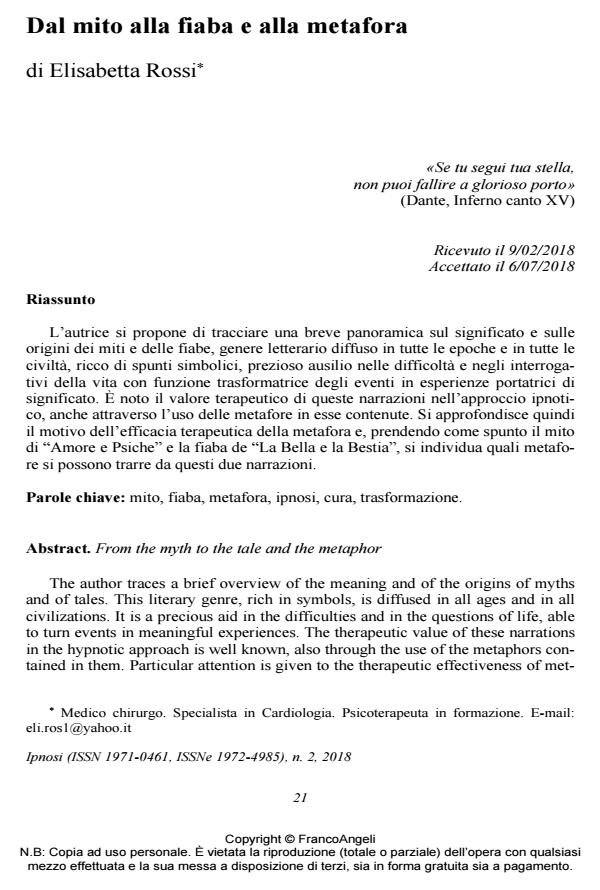From the myth to the tale and the metaphor
Journal title IPNOSI
Author/s Elisabetta Rossi
Publishing Year 2018 Issue 2018/2 Language Italian
Pages 17 P. 21-37 File size 198 KB
DOI 10.3280/IPN2018-002002
DOI is like a bar code for intellectual property: to have more infomation
click here
Below, you can see the article first page
If you want to buy this article in PDF format, you can do it, following the instructions to buy download credits

FrancoAngeli is member of Publishers International Linking Association, Inc (PILA), a not-for-profit association which run the CrossRef service enabling links to and from online scholarly content.
The author traces a brief overview of the meaning and of the origins of myths and of tales. This literary genre, rich in symbols, is diffused in all ages and in all civilizations. It is a precious aid in the difficulties and in the questions of life, able to turn events in meaningful experiences. The therapeutic value of these narrations in the hypnotic approach is well known, also through the use of the metaphors contained in them. Particular attention is given to the therapeutic effectiveness of metaphors and, through an analysis of the myth of "Eros and Psyche" and of the tale "The Beauty and the Beast", the author finds which metaphors can be drawn from these two stories.
Keywords: Myth, metaphor, hypnosis, cure, transformation.
- Apuleio. (1955). Le metamorfosi o l’Asino d’oro. Milano: BUR.
- Barker P. (1987). L’uso della metafora in Psicoterapia. Roma: Astrolabio.
- Bateson G. (1979). Mente e natura, un’unità necessaria. Milano: Adelphi.
- Bettelheim B. (1980). Il mondo incantato. Milano: Feltrinelli.
- Campbell J. (2008). L’eroe dai mille volti. Torino: Lindau.
- Casula C. (2002). Giardinieri, principesse porcospini. Milano: Franco Angeli
- Da Silva S., Tehrani J. (2016). Comparative phylogenetic analysis uncovers the ancient roots of Indo-European folktales. Royal Society Open Science.
- Dekker T., Van der Kooi J., Meder T. (2001). Dizionario delle fiabe e delle favole. Milano: Bruno Mondadori.
- Erickson M. (1983). La mia voce ti accompagnerà. Roma: Astrolabio.
- Erickson M., Rossi E.L. (1982). Ipnoterapia. Roma: Astrolabio.
- Gordon D. (1978). Metafore terapeutiche. Roma: Astrolabio.
- Jacobi J. (1965). La psicologia di Jung. Torino: Bollati Boringhieri.
- Jensen M., Adachi T., Tomé-Pires C., Osman Z., Miró J. (2015). Mechanisms of hypnosis: toward the development of a biopsychological model. International Journal of Clinical and Experimental Hypnosis, 63(1): 34-75. DOI: 10.1080/00207144.961875
- Jung C.G. (1980). L’uomo e i suoi simboli. Milano: Longanesi
- Jung C.G. (2013). Introduzione alla psicologia analitica. Torino: Bollati Boringhieri.
- Jung C.G., Kerény K. (1972). Prolegomeni allo studio scientifico della mitologia. Torino: Bollati Boringhieri.
- Kast V. (2006). Le fiabe che curano. Milano: Red.
- Kihlstrom J., Glisky M., McGovern S., Rapcsak S., Mennemeier M. (2013). Hypnosis in the Right Hemisphere. Cortex, 49 (2): 393-399.
- Lakoff G., Johnson M. (1998). Metafore e vita quotidiana. Milano: Bompiani.
- Levi-Strauss C. (1990). Antropologia Strutturale. Milano: Il Saggiatore.
- Malinowski B. (1976). Il mito e il padre nella psicologia primitiva. Roma: Newton Compton.
- Propp V. (1966). Morfologia della fiaba. Torino: Piccola Biblioteca Einaudi.
- Trevi M. (1972). Prolegomeni allo studio scientifico della mitologia. Torino: Boringhieri.
- Watzlawick P. (1984). Il linguaggio del cambiamento. Elementi di comunicazione terapeutica. Milano: Feltrinelli.
- Watzlawick P., Beavin J.H., Jackson D.D. (1967). La pragmatica della comunicazione umana. Roma: Astrolabio.
- Abito prêt-à-porter o capo sartoriale? Approccio conversazionale canonico per superare una criticità a confronto con l'uso della trance ipnotica evocata tramite la metafora confezionata su misura Mirella Mostarda, in IPNOSI 2/2023 pp.51
DOI: 10.3280/IPN2022-002004
Elisabetta Rossi, Dal mito alla fiaba e alla metafora in "IPNOSI" 2/2018, pp 21-37, DOI: 10.3280/IPN2018-002002